I started smoking salmon many years ago, I’ve experimented and tested many different ways over the decades, and it can be one of the tastiest basic smoking recipes that I know.
Will go through all the ways to smoke salmon, which create awesome results as you will see in the pictures.
I will also cover some of my favorite rub recipes at the bottom which is the meat curing aspects.
The basic way I use is shown below, which has been refined over a few decades. However, cooking and smoking are all about experimenting too of course.
You will also find a list of flavors and herbs, that go well with smoked salmon.
Plus tricks and tips.
Catching fresh salmon or buying fresh, you want to make sure that the salmon has a good story behind it like any food (farmed salmon can have quite a lot of hormonal additives, do some research – support the ethical companies!).
You can for sure make it a short prep time, but you won’t get as much smoke flavor into the salmon.
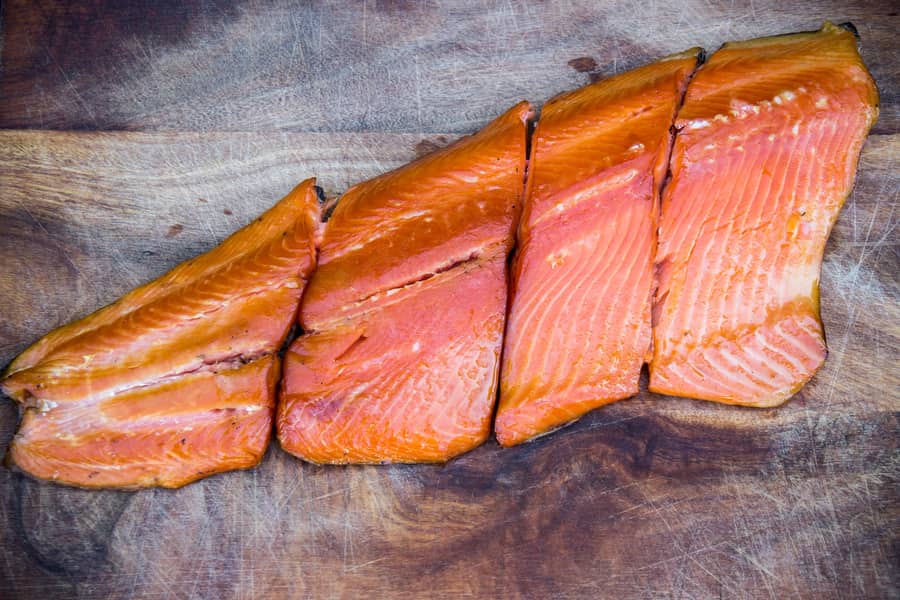
You can use any smoker, I will cover off the various types I have used. Because the salmon isn’t dense like beef or pork, it will cook through quite fast.
Additionally, you can do a dry or wet cure/brine of the salmon – I’ll go over these 2 different methods and how they effect outcomes also.
Salmon Smoking Options Fast Direct Portable Smoker or Slow and Subtle
I find the faster option will have a more subtle smoke flavor, and the slow/subtle method will create a deeper smoke flavor. The salmon has more time in the smoke, therefore the smoke vapor can attach to the pellicle more.
Here are the 2 ways of hot-smoking salmon, the steps also are the same apart from the smoker and time it takes to smoke/cook.
Indirect Heat or Low & Slow Hot Smoking
- Electric / Gas Smokers
- Pellet Grill Smokers
- Charcoal smokers (kettle for instance)
- Any other Indirect Heat Hot Smoker
- Gas Grill with a Smoke Generator (pellet tube or smokai smoke generator)
These smokers will all do a great job at smoking salmon and many other meats & foods.
Having a thermostat-controlled option can make this a set-and-forget cooking session. (pellet grill, electric etc.)
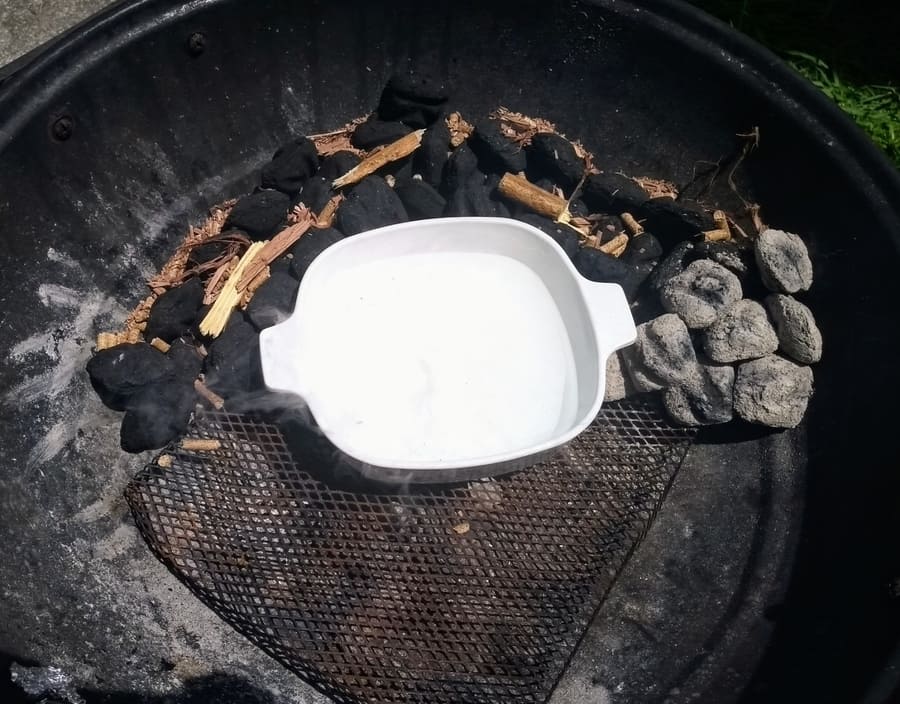
If you have a charcoal kettle, the “snake method” works great for a charcoal kettle grill setup too. It just takes a bit of time to get the initial charcoal fuel going before adding it to the kettle.
Remember to add hot boiling water, or else will will take quite some time to get the smoker up to temperature in the smoker.
Fast Hot Smoking (more on hot smoking fish in general)
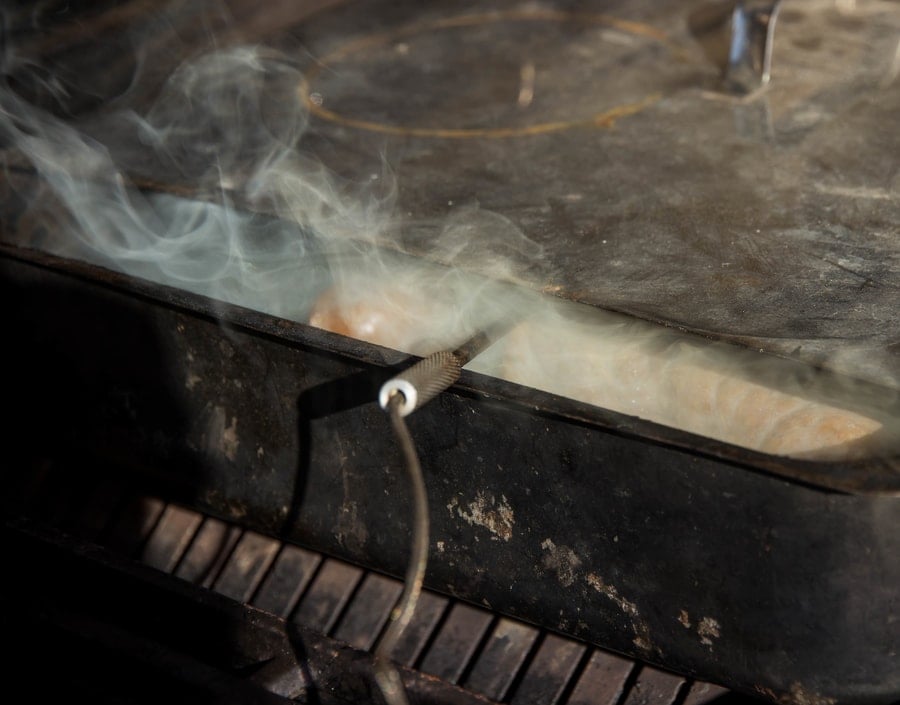
This is generally done in a much more confined smoking area, which means the salmon is surrounded by smoke. The heat comes directly from below, this is a standard method in many countries in the world now.
I’ve used a portable smoker inside with the kitchen extraction fans on full, it didn’t set off the fire alarm, though I would not recommend this.
You are better off using this in an outdoor environment with some form of heat element.
The main name for this is box smoker or portable smoker. If you aren’t familiar with these, more info is below.
I find that the temperature can be around 265-320°F / 130 – 160°C for 15 to 30 minutes, depending on the thickness of the fillet.
Equipment Used
- Salt – sea salt or kosher salt (not iodized)
- Salmon – doesn’t have to be a whole fillet
- Hot Smoker (costs of these), Portable Smoker, Gas BBQ, or Kettle Charcoal BBQ
- Dry smoking wood (to suit smoker)
- Bowl with a lid to cover when curing salmon
- A cooling rack, hang or on chopsticks – to get airflow to develop a
pellicle - Tweezers (optional)
How To Hot Smoke Salmon
- Brine or salt dry cure the salmon
- Place salmon covered in the fridge for at least 4 hours
- Wash off the salt cure
- Form the pellicle, uncovered in the fridge for a minimum of 1 hour
- Remove once the fish flakes easily or the target temperature has been reached
I would give yourself at least 16 hours to prepare, before the smoking/cooking. Mainly for the pellicle formation, a key step in the process.
Steps in Hot Smoking Salamon
1. Brine or Salt dry cure the Salmon
You know that salmon is not a uniform, even shape, so if you are smoking a whole fillet, the dry salting can be less toward the tapered end.
The moisture content is relatively even across the fillet. If you want, you can cut the fillet into strips before smoking. They will cook/smoke faster. (I did this in the pictures to test different salt levels for this post.)
Generally most people like myself like to brine the salmon, it effectively helps hold the moisture inside the salmon during the smoking/cooking process.
Salt Dry Curing
2 types of dry salt curing can be done.
Saturation Salt Curing for Hot Smoked Salmon
Salt curing can be more inconsistent, depending on the salt and the coverage on the meat, as well as how long you leave the salt cure on the meat.
4-8 hours is often enough in a thin layer of salt, then wash off, and put on rack to dry and form a pellicle.
It often depends on the thickness and type of salt – when it comes to how long it takes for salt to bind/diffuse into meat. Slicing a small piece off after washing it off and frying it up is a great way I use to test the saltiness before drying for the pellicle and smoking it until cooked.
Equilibrium Dry Salt Curing for Hot Smoked Salmon
From the above experience, I think 1-2% sea salt of the salmon’s total weight would work well. Funnily enough, with equilibrium curing, 1-3% is generally the guideline (here is an article I wrote on equilibrium curing).
Salt Brining
For an easy universal salt brine, you need 5% salt to 1 quart or 1 Liter
For example, 4 cups of water for each 1/4 cup sea salt or 50 grams or 1.8 oz (approx)
Also known as, ’20 degrees’ in a commercial sense, measured by a salometer. Much stronger brines are used to quickly brine commercial fish.
Just remember different salts take up different volumes, so measuring with some accurate scales does help a lot (especially with equilibrium dry curing for salumi, etc.).
I would call this an overnight brine, wouldn’t leave it in for more than 24 hours personally. Don’t worry if you over brine, you can just soak it in fresh water for maybe 30 minutes.
I like to try it and see how salty it is at this point. Slice off a small amount and fry it up in a pan.
A 5% brine is a good guide for most people’s salt taste preferences I have found. Below, I did some homework to figure out the sweet flavor of brine if that is what you are after.
Different Sugar Ratios to Salt
I experimented to help you work out how much sugar you may want to put in there brine. I had a group of friends that have varying taste buds when it comes to sweetness.
I cut a salmon fillet into 4 pieces and tried slightly different curing ratios. All were removed for 8 hours or overnight the next morning.
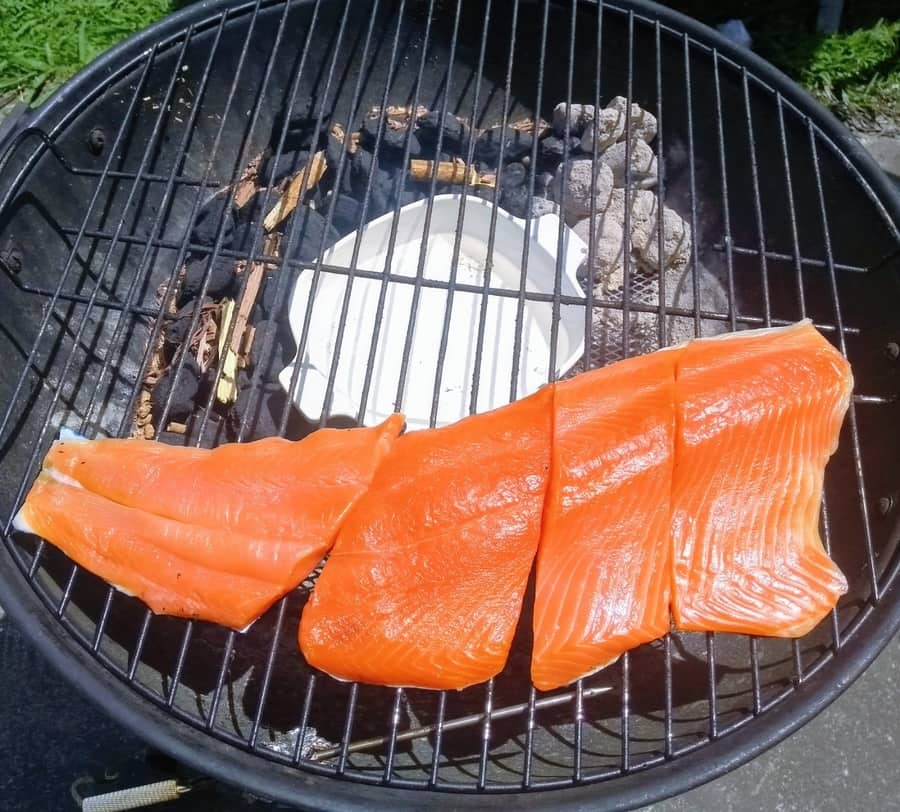
| Brine Type | Salt Percentage | Sugar Amount | Sweetness Level |
|---|---|---|---|
| 5% Wet Brine | 5% | 1.7 oz (50g) | Light sweetness |
| 5% Wet Brine | 5% | 3.5 oz (100g) | Moderate sweetness |
| 2% Dry Cure | 2% | 1% | Moderate sweetness |
| 5% Wet Brine (No Sugar) | 5% | 0% | No sweetness |
I split the salmon so that piece was 250g or 8.8 oz of salmon.
We found them all enjoyable; amounts of 100 grams or less of sugar per 1L of water were favored
5% Wet Salt Brine & 1 cup of sugar for 1 quart is used for many recipes online. I tend to avoid this high level of sugar.
Personally, this makes the salmon too sweet and overpowers the flavor of the salmon.
Optional Curing Spices & Flavors
For wild and farmed salmon I use white wine, bay leaves, garlic, pepper, and fresh herbs.
You can use teriyaki sauce and a host of other condiments. Many are generally sweet because they use sugar as a preservative. My preference is for less processed, more natural additives.
Flavor Ideas for a salmon wet brine:
- Bay leaves
- Garlic
- Fennel
- Mustard seeds
- Dill (popular in Scandinavia)
- Lemon Pepper
- Lemon or Lime Zest
I good guide for most herbs and spices is 0.1-0.3% weight to every 1kg or 2.2pds of salmon. Often enough to flavor without overpowering, I’ve found.
You can use many different herbs and flavors, and often, they will come through more subtly than other styles of cooking.
Any spice or herb that goes or pairs with meat can be used. With salmon, I generally just want the smokey, delicious salmon flavor to come through.
2. Place Salmon Covered in the Fridge for at Least 4 Hours
Based on the brining method above, 4 to 5 hours will be enough to cure the salmon so it is ready for drying. Overnight is the preference, you could go as long as 24 hours, and you might get quite a salty outcome.
I don’t find any need to turn or play around with it; I just use good, tight Tupperware to keep it all locked in.
3. Wash Off the Salt Cure
Some folks I have heard use white wine to wash the salmon fillet. I find this too much. Did it once, but didn’t find any change in flavor after the smoking was done.
Wash the fish under the cold water tap for a minute or two.
The salmon meat has become slightly firmer due to the curing or brining.
4. Dry the Fish to Form the Pellicle
I find it best to place uncovered in the fridge, on a rack is the ideal method I think. On cooler winter days, I have hung salmon fillets in a breezy shed that has some air flow.
The fridge is ideal because it is cool, of course, but it also runs at approximately 25-50% humidity and should have some airflow. These are great conditions for forming a pellicle.
Because your salmon is cured, I find it won’t leave off any smell in the fridge either.
In summary, the pellicle is when the protein on the outside of the meat binds together to protect itself. It has a tacky, slightly glossy look to it.
It helps the smoke adhere the gases (it’s not smoke that flavors the meat) to the meat.
If you want to read more about pellicle formation, I wrote a full post on it here.
5. Remove Once Fish Flakes or Target Temperature Has Been Reached
Time & Temperature
As a guide, I will use between 140-180°F / 60-82°C for 1.5 to 3 hours.

This does depend on the thickness of the salmon fillet.
Luckily, the good, healthy fat in salmon means it is harder to overcook. Also, the salt curing makes it harder to overcook the fish. Curing & brining helps hold the moisture in during the cooking/smoking process.
If you are using a built-in thermostat, it can sometimes be inaccurate. I have found that the location of the salmon inside the grill or kettle can sometimes not reflect the temperature on an external thermometer. I have seen some be off by up to 50°F.
Using a reliable thermometer can help you get more accuracy. Keep it away from the metal racks also, since the heat will be radiated from them. Try and have a thermometer at the same height as the salmon you are smoking.
Thermometers are top-rated nowadays with backyard smoking enthusiasts, especially with the longer low and slow style. If you smoke something for half or a whole day, you want to keep the temperature consistent. It’s not essential, it just makes it easier.
If you want to check out a few thermometers I discussed, please find them here.
Cooking the salmon until it can easily break away when you push a fork into it makes sure it’s cooked through properly.
Or
If you want to get technical, 145°F / 62.8°C is cooked (USDA Guidelines). Over about 155 F is when it will become overcooked.
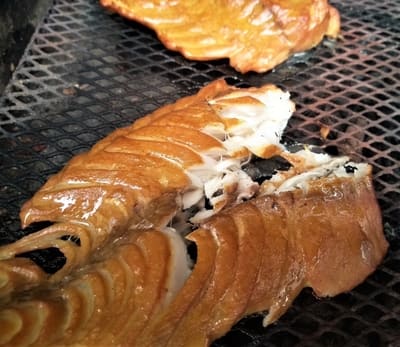
Slightly under salmon is a lot more enjoyable then slightly over.
Hot Smoked Salmon Tips & Tricks
Remove Pin Bones – Makes Eating Easier
Quite often, bought salmon has the pin bones removed. However, you should run your finger across the rib cage area of the fillet to see if they are protruding.

A chef’s trick is to run a knife backward across the fillet to expose the bones more.
Tweezers are good, small pliers even better. You don’t have to remove the pin bones. However, when you present the glorious smoked salmon, it is more enjoyable without bones.
Some people prefer to remove the pin bones after brining, as it can be easier.
Skin On – Easier
I find that having the skin on protects the flesh during the smoking process. Since you will be smoking with the skin side on the bottom, it works fine without the skin, too.
The bottom part of the fish will just be slightly more cooked through if you remove it. I do like to fry up the skin in a pan it becomes a crunchy nugget of flavor (no oil needed, natural fats are used)!
When I first started smoking fish I was catching trout, I would use a 2:1 ratio of salt to brown sugar. I would sprinkle it on quite lightly. Leave it overnight covered in the fridge. It was then ready for the portable smoker.
The next morning, I would use stronger wood sawdust, like oak, and fire up the grill BBQ. I used a portable smoker for 10 years, it was mainly during fishing or camping trips, and it was so convenient to use. Just kept it wrapped in a blanket so it didn’t mess up any other gear.
Loved the finished product and it produced a much lighter flavor than the low and slow smoking I now do. You could call this a fast fish-smoking method.
If you want more information on the portable smoker, I wrote about it here.
The method below is for a more refined outcome using an electric, gas, pellet, or charcoal smoker. Having a bit of control over the temperature means you can adopt the low and slow styles. This means more smoke flavor due to longer exposure to the smoke gases (it’s the gases supposedly that flavor the meat and have antibacterial properties).

Optional Basting for Sweetness
If you want to add some sweetness to the salmon, honey or maple syrup is common in many book recipes. I prefer without, but each one to their own. I want the smoke and salmon flavor to come through unadulterated.
What is the White Stuff on Smoked Salmon?
One thing to be careful about is too much heat. If you don’t watch it, you will see a puddle of white substance on top of the salmon fillet. I think this is mostly due to overheating. It’s an easy fix: You can just wipe it away.
You will generally always have some, either a little or a lot.
This substance is coagulated protein known as albumin and it is pushed out of the salmon during the cooking process.
Don’t Forget a Water Pan For Slow and Subtle Smoking
You will find it easier to regulate heat if you use a water pan. As a backup, if it gets too hot, You can throw in some ice.
If you are using a box/portable smoker this won’t be necessary, since you are smoking over a short period.
Portable Smokers – Faster & Hotter Smoking
As mentioned, this was my go-to option when catching a lot of trout and a few salmon. I still use it extensively for specific holiday outings.
It can work very well, especially if you don’t want the full smoker setup. It does take some adjusting.
It’s not essential, but if you want to get a better idea of what is going on in the smoker, I would suggest buying a thermometer you can poke into the smoker.
The smoker takes direct heat from below; the wood sits at the bottom of the smoker box. A small rack is above it, and the meat or food sits on the rack. A good portable smoker has only 2 pieces the molded box and a good sliding lid.
Not all portable smokers were created equal, I have known a few people who bought designs that leaked heat or riveted, here is a post I wrote about some decent ones.
Tip: A small amount of wood can produce a lot of smoke and flavor in a portable smoker. With some certain fruit woods, I ended up with thin yellow smoke instead of the common blue smoke from most smoking hardwoods, which looked very cool.
If you want some tips on universal smoking woods, please find them here.
How To Store Hot Smoked Salmon
An airtight container tucked away in the fridge will keep the salmon happy. As mentioned, the smoke flavor will get a bit stronger, once it has been in the fridge for a day.
How Long Does Hot Smoked Salmon Last?
You will find if refrigerated, about 10-12 days. It has a little preserving going on. This is cooked salmon with some smoked flavor.
Hot Smoking does not preserve the fish much at all, if you want more information on hot smoking and why is does not preserve, I wrote a post comparing hot & cold smoking here.
Smoking Wood for Hot Smoked Salmon
From my experience, fruit woods like apple, cherry, grape, and pear work incredibly well.
Oak or maple, I consider medium wood, and it also works out well.
Being a softer flavor than red meat, I would keep away from pure strong hardwoods like mesquite. Mixing the heavier smoke-flavored woods is also an option.
There is a lot of internet talk about the flavors of wood, personally apart from light, medium and strong. Can’t say I have noticed specific flavors that some claim.
Ways to Use Hot Smoked Salmon
Because it should come off the smoker moist & soft, it has many ways you can use it. It firms up a little when cooled.
7 Ways to Use Hot Smoked Salmon
- Just straight from the smoker
- Hot smoked salmon paté
- Egg Benedict with hot smoked salmon
- Mixed in with scrambled eggs
- Hot smoked salmon pattie
- In a quiche
- Mixed into a pasta dish
- Kedgeree (light Indian/UK curry, egg, rice, smoked fish)
Different Types of Salmon for Smoking
I haven’t found a salmon type that doesn’t hot-smoke nicely. If you would generally bake it, then smoking it will work fine.
Most of the salmon I have smoked have been chinook, most salmon seem to take on smoke flavor nicely that I have tried.
It is always best to find what is local or closed, in my opinion.
Is Hot Smoked Salmon Healthy?
Considering there are so many healthy fats in salmon, you are getting some good nutrition. It depends on the quality of the salmon and, of course, the traceability of the source. Wild and farmed can be completely different depending on where you are.
Smoke vapor has anti-bacterial properties, I read about this in a smoking book.
Other Useful Related Articles:
https://eatcuredmeat.com/the-best-portable-smokers-for-camping

Tom Mueller
For decades, immersed in studying, working, learning, and teaching the craft of meat curing, sharing the passion and showcasing the world of charcuterie and smoked meat. Read More
